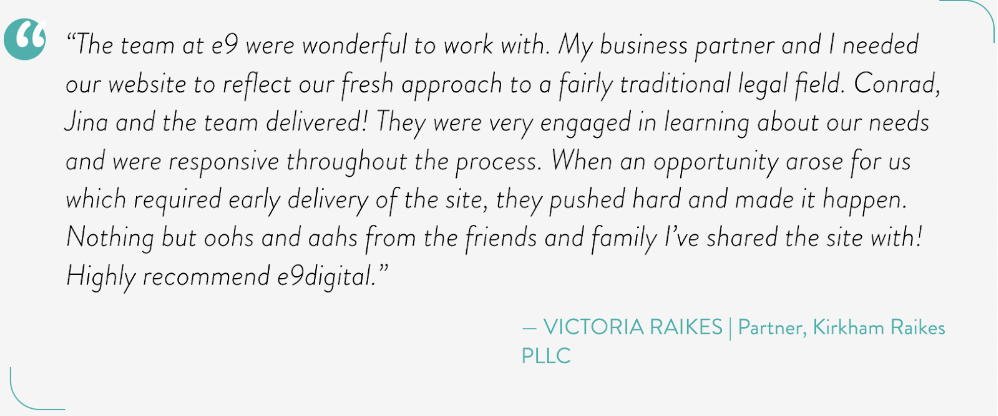Law firms of all sizes benefit from a website. Potential clients don’t use the Yellow Pages to find the type of lawyer needed to represent their case. Instead, they ask for referrals.
It’s true. Approximately 59% of legal clients seek a referral to find a lawyer. Only 17% of clients use Google to find a lawyer. So, while you’re still missing out on client acquisition if you don’t have a website, the biggest piece of the pie comes from referrals.
So if most business comes from referrals for websites, why the heck do I need a website? (You may be asking).
When someone refers a lawyer to their friend, what do you think is the first thing that the friend does before calling?
They Google their website.
So, even if they don’t find you through Google initially, every lawyer should have a website for the halo of credibility. Potential clients can learn more about you and feel confident in their decision to contact you. Also, if you have a website, they know that you’re real and not some creepy dude working out of his 80-year-old grandpa’s basement.
Websites also help weed out clients who aren’t the right fit. If someone needs a personal injury lawyer and their friend referred them to a family lawyer, then they’ll see that on your website. Legal websites should outline practice areas and case wins, so any visitor can see exactly what you offer and why they should work with you.
To get the most bang for your buck, ensure that the website design agency you choose to work with includes these 9 must-have elements.
1. Provide Expertise Through Legal Blogs and Content
The first goal of every blog should be to educate potential clients about important legal matters. A website is a lawyer’s chance to prove their expertise to potential clients before they even hop on the phone. Create content on your website that offers valuable information about your area of expertise. If you help a client first through a blog post about amputation risks for construction workers, then they’ll be more likely to come to you for personal injury issues.
Blogging regularly highlights your knowledge and secondly, helps promote your business through search engine optimization (SEO). This is the process of making your website more likely to appear on Google’s search engine. When you create blogs with knowledgeable, relevant content, Google rewards you with a higher ranking on the search engine results page.
There are quite a few types of content other than blogging that lawyers can use to impress potential clients, including:
- Legal Guides: An in-depth look at how to solve an issue in your subject area. Making these downloadable gives you email addresses and phone numbers to follow up with for client acquisition.
- Social Media: Use Instagram, Facebook, YouTube, Twitter, you name it to share videos that showcase your expertise.
- Case Studies: Highlight in one to five pages a case of yours that you handled successfully.
- Ebooks: Similar to guides, ebooks use imagery and graphics to teach interested clients about a particular subject area.
All of this content must follow the American Bar Association’s Model Rules of Professional Conduct, under rules 7.1 and 7.2. Rule 7.1 states “A lawyer shall not make a false or misleading communication about the lawyer or the lawyer’s services.” So, be honest in your content and back everything up with facts.
Ethics rules like these can also vary between states. Be sure to check within your state to ensure your content follows the required protocol.
2. Reduce Stress With a UX Design
Many lawyers see clients undergoing extremely stressful situations. Whatever the circumstances may be, people don’t want your website to add to their frustration. Every website designer should prioritize the user experience (UX) in legal websites. This means that there’s a seamless journey from landing on the homepage to completing the desired action, such as filling out a contact form.
UX design gives law firms a great first impression. It proves to your target audience that you can solve their problems in a digestible format. All the information they need can be found on your website, offering transparency about your business. The following items are the landmark qualities of a UX design.
- An easily navigable menu
- A visual hierarchy that puts the most important information first
- An intuitive feel that works on both desktop and mobile
- Enough white space so the design doesn’t feel cluttered
- CTA buttons that simplify taking action
3. Offer Clarity With a Simple Services Overview
Clients most often come to lawyers with a specific need in mind. For example, if a business owner needs to protect themselves during a tax audit, they need a tax lawyer with experience in the U.S. Tax Court.
Legal websites must include a page that highlights specific legal services. Break down each specialty that’s offered for your practice area. A drop-down menu can be utilized to make it easy for clients to find the exact service needed.
4. Show Your Personality With Custom Photography
Law is a competitive field, with nearly 200k lawyers in New York alone. Custom photography is one of the best design choices to help your website stand out from the crowd. While words are an important part of your website, people are less likely to reach out if they aren’t compelled by the visuals.
Plus, professional photography gives your website a custom feel. It highlights your culture and brand, showing the real people who work in your office and that future clients will meet.
See the difference for yourself! Custom vs. stock photography for Damali Law
If it’s within your budget, add some personalized videos as well. People are 52% more likely to share video content than any other type of content, so it’s a good tool to increase your reach. A video can be anything that helps your client. Offer short bites of thought leadership to educate viewers and film quick breakdowns to highlight your problem-solving services.
5. Display Proof of Previous Happy Customers
People tend to have a bad taste in their mouths about lawyers. What they know of lawyers comes from what they see on TV. When they need a lawyer in real life, it’s often for a trying circumstance. So, you need to impress upon people that they can have a positive experience working with you.
The best way to do so is with social proof from past clients. Ask for reviews to add to the website right after you win a case. Source positive comments and testimonials from Yelp, LinkedIn, or other social media. Highlight these on your homepage, so it’s one of the first items that people see when they visit your website.
6. Highlight Your Unique Selling Proposition
While there may be hundreds of IP lawyers in your area, none of them have the exact qualifications that you do. A key to setting yourself above the rest is to highlight your unique selling proposition (USP).
Ask yourself the question: what does your law firm do well that your clients need?
To figure this out, follow these steps.
Step 1. Complete a SWOT analysis, which stands for strengths, weaknesses, opportunities, and threats. Make a list under each word of each for your law firm. This reveals what you have to offer that others don’t.
Step 2. Look at your competitor’s websites and see what skills they highlight. Offer something they don’t or phrase your services differently.
Step 3. Study your target audience. Consider the legal issues they have and how you can frame your website to serve their needs.
Once you have these three items in mind, craft a single-sentence statement, the USP, that encompasses these items. This can then be the first header on your homepage, and it will help keep people on your website because it shows the one-of-a-kind value that your law firm provides.
7. Encourage Peace of Mind With a Trustworthy Color Scheme
Our minds naturally draw conclusions from certain colors. They can impact our moods and offer subconscious first impressions. For a law firm, choose colors that reflect the services that you offer. For example, green is an obvious choice for finance lawyers. It’s the go-to color when someone thinks about money, and it also naturally evokes a feeling of balance and serenity.
8. Showcase Professional Biographies
Continue to build your credibility before someone contacts you with a well-written biography. It should highlight your achievements, showcase your credentials, and outline your areas of expertise. The biography should be long enough to explain your experience but don’t go overboard with verbose details. Keep content succinct and relevant to the reader.
Additionally, add a one-line statement that includes a detail from your personal life.
This helps clients connect with you on an emotional level. You’re not only a lawyer, you’re a regular person, just like them.
9. Always Include Accessibility
Title III businesses are ones that regularly serve the public. These must follow ADA compliance standards and develop “reasonable accessibility” for their websites.
Law offices are under the umbrella of Title III businesses.
Don’t suffer the embarrassment of being a lawyer who gets sued because their website is not ADA-compliant. Hire a website design firm that specializes in ADA compliance.
Not only is it the right thing to do, it’s just good business to be ADA compliant. 13% of Americans live with a disability. When your website is ADA-compliant, all those people can now secure legal help from your firm. e9digital specializes in website accessibility, and we have a dedicated team on staff that’s well-versed in the best practices. We make your website accessible and then do ongoing audits to ensure it stays that way.
Create Your Halo of Credibility With e9digital
e9digital has partnered with countless law firms to create websites that attract their target audience. We know that no law firm is the same, so we hone in on key unique company or client traits that dictate the identity of the final product. Learn more about how e9digital can design a law firm website around your USP and contact us today.

